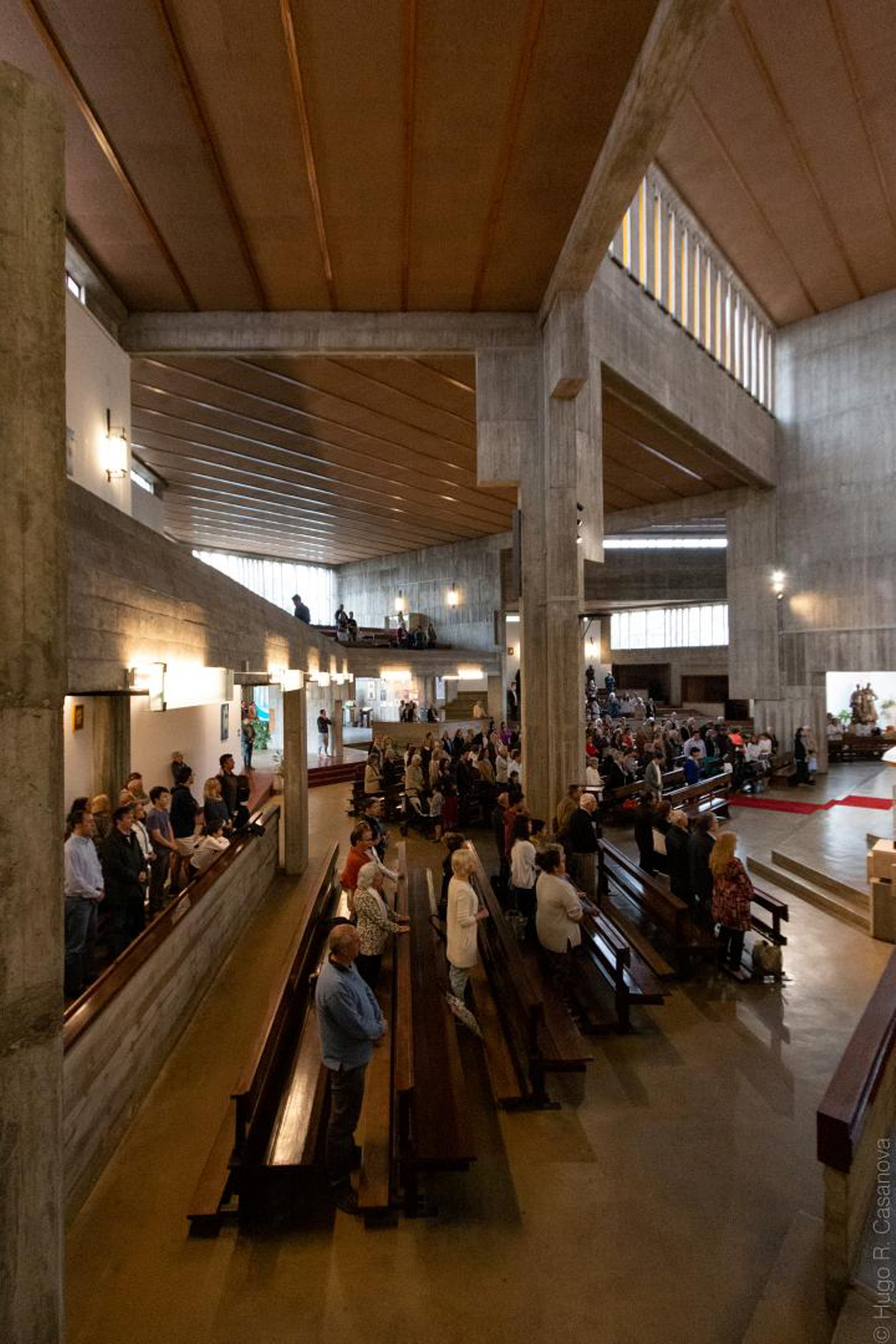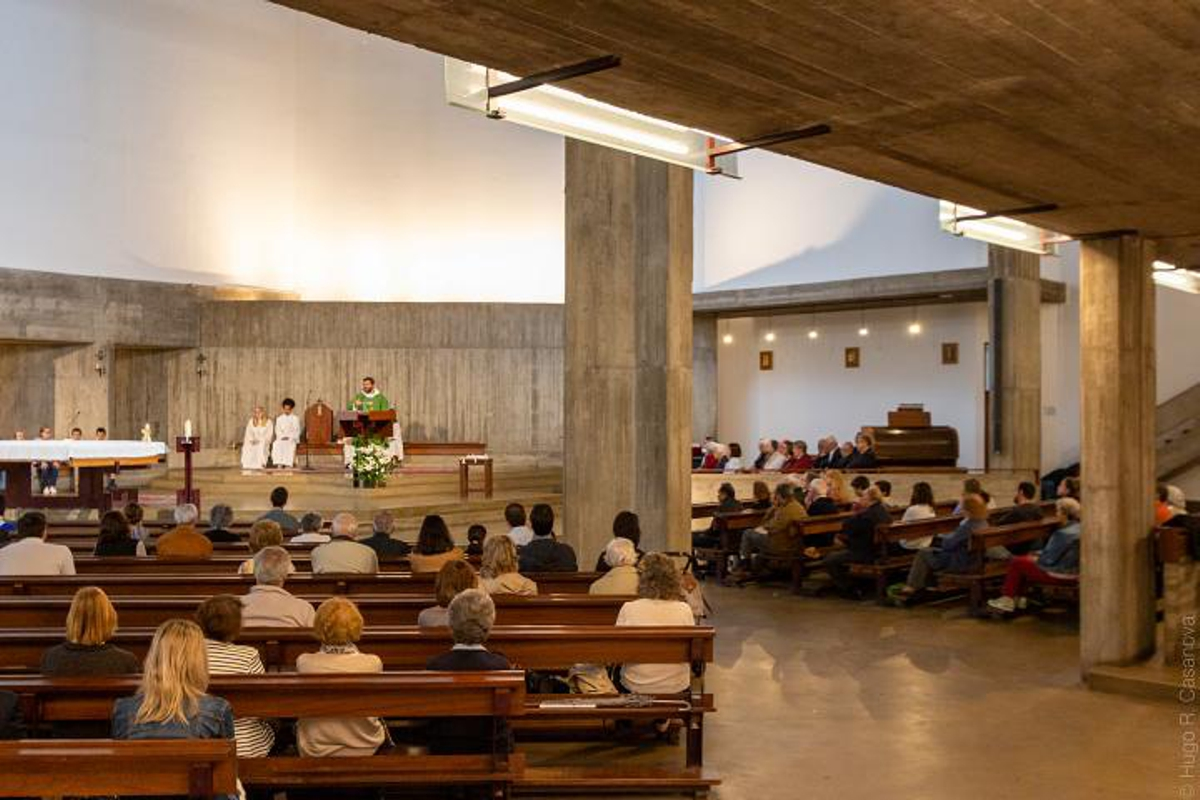Versão portuguesa aqui.
GPS 38.69609590590453, -9.292556261093187
«Involving, modern, spacious and functional church, thought and proposed in the spirit of the Second Vatican Council to accompany the apostolic way of its and of all times»: it is in these terms that the architect and researcher João Alves da Cunha describes the parish church of Paço de Arcos, municipality of Oeiras, Patriarchate of Lisbon.
The researcher coordinates and signs one of the texts in the book “Igreja da Sagrada Família de Paço de Arcos – 50 years of modern religious architecture /1969-2019”, which will be launched in this space, on 24 August, the date on which the fiftieth anniversary of his consecration to God (dedication).
After the preface, written by the current parish priest, Fr. José Luís Costa, the architect José Manuel Fernandes writes the preface (“The modern church of Paço de Arcos”), followed by “Photographic memory” (José Nunes Correia) and “History construction” (João Alves da Cunha) – a chapter transcribed below.
“The church according to the author” (João de Almeida), “Drawn pieces” and “Photographic record” (Hugo Casanova) conclude the book with about 100 pages.
The work brings together unpublished material from the personal archive of the architect João de Almeida, and from the archive of the parish of Paço D’Arcos and the Archive of the Municipality of Oeiras, highlights the parish priest.
The parish church of Paço de Arcos was built in the context of the MRAR - Movement for the Renewal of Religious Art, bringing together architects, plastic artists and historians such as Nuno Teotónio Pereira, Nuno Portas, Diogo Lino Pimentel, Luiz Cunha, Madalena Cabral, Maria José de Mendonça, António Freitas Leal, Manuel Cargaleiro, José Escada and Eduardo Nery.

History of the construction of the “Igreja da Sagrada Familia de Paço de Arcos”
At the beginning of the 1960s, Paço de Arcos was characterized as a town experiencing rapid population growth. It had around six thousand inhabitants at the time, registering that a third of these claimed to be Catholic. For the celebration of worship, this community only had, in addition to the small private chapel of the Palácio dos Arcos, the also small chapel of Senhor Jesus dos Navegantes, whose capacity was clearly reduced. However, that was not the only limitation of that space. There was a lack of minimally qualified facilities or dependencies, which made it difficult for existing religious bodies to function, as well as making it impossible to create others whose presence was considered indispensable.
Likewise, the desire to create the parish of Paço de Arcos grew, justified by better administration of the growing local community. Paço de Arcos was at the time a vicariate integrated into the parish of Oeiras, more precisely since March 30, 1944, despite having already been a civil parish since December 7, 1926. The Cardinal Patriarch of Lisbon D. Manuel Gonçalves Cerejeira agreed with this claim, but would only authorize it through the existence of a worthy parish church. In this context, a group of parishioners decided to get down to work and set up a commission to carry out the construction of the new church in Paço de Arcos, a task that was not free from multiple setbacks, despite their commitment.
The chosen location was excellent. The church would rise in the center of a residential area under construction at the time, in an area known as “Quinta do Meireles”, belonging to Engineer Jean José Luz Coruche. Frankly central, it would be located next to a motorway of some importance, as it was the connection between the still new marginal road and the future motorway between Lisbon and Cascais, which at the time ended next to the National Stadium, in Jamor.

In 1963, the collaboration of the SNIP – Secretariat of the New Churches of the Patriarchate was requested, and this diocesan service sent a copy of the Directives for the construction of Churches in the Patriarchate, published in September 1960, together with the program for the new church, “made in According to the project elaborated by Dr. Coimbra Torres, with some changes in details and a different systematization”. In this document, after exposing and validating the reasons that imposed “the construction of a modern and wide Church and a Parish Center able to accompany the apostolic way of our time”, a positive reference was made to the place destined to the construction of the church: located in the center of the village, with good road access and close to the train station, market and shopping area. Regarding the church's program, the document referred to the Directives for the construction of Churches in the Patriarchate, without further description "because we have a vote of confidence in the Architect". The only data proposed was related to the capacity of the church: between 500 and 600 seats and around 330 standing.
The architect chosen to design the new church in Paço de Arcos was fully trusted by SNIP. It was Fr. João de Almeida, one of the main people responsible – along with the architects Nuno Teotónio Pereira and António de Freitas Leal – for the founding, in 1953, of the MRAR - Movement for the Renovation of Religious Art.
In formal terms, the project embraced the “Late Modern” trend, a language that translated into a complex and very expressive concrete architecture that, in the words of João de Almeida, created “concrete sculptures”.

From the point of view of architectural expression, João de Almeida sought to reduce the massification of the building through a decomposition of the volumes, something he considered essential, “to the extent that, combined with a unitary and concentrated conception, it gives the parish nucleus a certain character of monumentality that distinguishes it, without separating it, from the set in which it is inserted”. The establishment of an integrated relationship between the church and the surrounding buildings was, therefore, a concern that João de Almeida sought to resolve, both through architectural language and scale, and through the materials and construction techniques adopted.
Anticipating the long-awaited inauguration of the church of Paço de Arcos, the Cardinal Patriarch of Lisbon D. Manuel Gonçalves Cerejeira published, on July 30, 1969, the decree creating the also much-desired parish of Paço de Arcos, whose boundaries would coincide with those of the civil parish. The document, which would only come into force on the day of the inauguration of the church, attributed to this, as patron, the Holy Family. So, with this name, the church was finally inaugurated, on the 24th of August 1969, by D. António de Castro Xavier Monteiro, Archbishop of Mytilene.
Engaging, modern, spacious and functional Church, thought and proposed in the spirit of the Second Vatican Council to accompany the apostolic way of yours and of all times.